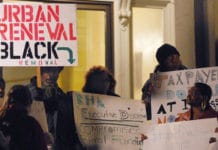by Lynda Carson
Oakland – With the long lasting effects of the on-going draconian sequestration budget cuts occurring, including the recent government shutdown, people in Oakland and across the nation are being stepped on, abused and treated like a punching bag.
 Due to the on-going $1.2 trillion sequestration automatic across-the-board spending cuts and the loss of tens of thousands of jobs as a direct result, it has become even more difficult for residents in Oakland to find work. It is very difficult to find employment that pays a living wage or to receive assistance for food, housing, energy bills, transportation needs, health care, dental work or child care.
Due to the on-going $1.2 trillion sequestration automatic across-the-board spending cuts and the loss of tens of thousands of jobs as a direct result, it has become even more difficult for residents in Oakland to find work. It is very difficult to find employment that pays a living wage or to receive assistance for food, housing, energy bills, transportation needs, health care, dental work or child care.
The Section 8 housing choice voucher program is also at risk in Oakland because the Oakland Housing Authority is facing over $11 million in budget cuts since the on-going sequestration budget cuts took effect on March 1, 2013, threatening thousands of low-income renters with rent increases or the possible loss of their vouchers. Low-income families in the Section 8 voucher program pay 30 to 40 percent of their income in rent each month, and the rest of the rent is paid to the landlord by the federal program.
With the long lasting effects of the on-going draconian sequestration budget cuts occurring, including the recent government shutdown, people in Oakland and across the nation are being stepped on, abused and treated like a punching bag.
Because the Democrats joined the Republicans in allowing the sequestration budget cuts to continue in the latest political deal known as a “continuing resolution” that ended the government shutdown on Oct. 16, it appears to be a very grim situation for Section 8 voucher holders in cities all across the nation. Housing officials claim that 140,000 voucher holders are at risk of losing their vouchers because of the sequestration budget cuts.
Sequestration is also shredding the Meals on Wheels Program that feeds senior citizens, and it means massive budget cuts to education, food programs, small business, food safety, mental health programs, emergency responders, Native American programs, public housing, Head Start, homelessness programs, AIDS and HIV treatment services, Community Development Block Grants, and many other vital services and programs.
Affordable housing developers scheme to grab Section 8 vouchers and public housing
Local non-profit so-called affordable housing developers, including Affordable Housing Associates, Resources for Community Development and the East Bay Asian Local Development Corp., have teamed up with local and national organizations that are pushing for Rental Assistance Reform (RAR) legislation to be passed in the House and Senate that is harmful to the poor.
RAR will result in fewer Section 8 housing choice vouchers for the poor, higher rents for public housing residents and the acceleration of the privatization of conventional public housing projects into privatized mixed-income residential housing developments for higher income renters. Developments that are being promoted by so-called non-profit and for-profit affordable housing developers who want to get their hands on public housing properties locally and all across the nation.
In California alone, during 2011 when Gov. Jerry Brown put more than 400 redevelopment agencies out of business, the so-called multi-billion dollar affordable housing industry began looking for other funding sources to continue its empire building. The industry decided on grabbing as much conventional public housing property as possible and wants to loot the Section 8 housing choice voucher program for more project-based vouchers.
Local non-profit so-called affordable housing developers have teamed up with local and national organizations that are pushing for Rental Assistance Reform (RAR) legislation to be passed in the House and Senate that is harmful to the poor.
The so-called affordable housing industry is pushing for RAR legislation to be passed in the House and Senate as soon as possible, and it may be tucked away inside legislation heading for Congress as soon as Dec. 13, 2013.
If lawmakers cave in to the pressures of the so-called affordable housing industry, the impact of RAR will result in more Section 8 housing choice vouchers being taken away from low-income renters in Oakland and all across the nation, so that they can be converted into project-based vouchers to fund so-called affordable housing projects for wealthy developers.
 Currently under federal law, each Public Housing Authority – there are 3,300 PHAs nationwide – is allowed to grab as much as 20 percent of the funding granted to them that is meant to be used for Section 8 housing choice vouchers for low-income renters and convert that funding for use as project-based vouchers – project-based vouchers that wealthy non-profit and for-profit so-called affordable housing developers can use to fund their projects. Now the so-called affordable housing industry wants RAR legislation to be passed that would allow PHAs to raise that 20 percent to 25.
Currently under federal law, each Public Housing Authority – there are 3,300 PHAs nationwide – is allowed to grab as much as 20 percent of the funding granted to them that is meant to be used for Section 8 housing choice vouchers for low-income renters and convert that funding for use as project-based vouchers – project-based vouchers that wealthy non-profit and for-profit so-called affordable housing developers can use to fund their projects. Now the so-called affordable housing industry wants RAR legislation to be passed that would allow PHAs to raise that 20 percent to 25.
RAR is a trojan horse – stealth legislation that was created under the guise of helping the poor but that actually promotes higher rents for poor people in public housing and the Section 8 housing choice voucher program and scales back itemized deductions for medical and child care used by the poor for rent reductions in those programs.
If passed, RAR would also set “flat rates” for higher income public housing tenants closer to market levels. In total the Congressional Budget Office (CBO) estimates that poor people in public housing and the Section 8 voucher program would pay about $1.75 billion more in rent over a five-year period because of the loss of itemized deductions for medical and child care, in addition to the major rent increases that would be imposed on public housing tenants.
Another aspect of RAR if passed into law would change federal law so that higher income families would be assisted by the nation’s federal housing assistance programs. Presently 75 percent of vouchers and 40 percent of project-based Section 8 and public housing units must be allocated to households with incomes at or below 30 percent of the local median income when they enter the program. RAR would instead require that those vouchers and units go to households with incomes at or below 30 percent of the local median or the federal poverty line, whichever is higher. By subsidizing the rents of higher income renters instead of low-income renters, the CBO estimates that the change would raise rent revenues and cut program costs by $1.12 billion over five years, because families admitted into the programs could afford somewhat higher rents.
RAR is a trojan horse – stealth legislation that was created under the guise of helping the poor but that actually promotes higher rents for poor people in public housing and the Section 8 housing choice voucher program and scales back itemized deductions for medical and child care used by the poor for rent reductions in those programs.
RAR also supports the Rental Assistance Demonstration program (RAD) that accelerates the privatization of conventional public housing and tests the conversion of public housing and Section 8 moderate rehabilitation units to project-based vouchers or Section 8 project-based rental assistance. RAD also allows similar conversions of units from the Rent Supplement and Rental Assistance Payment programs.
On Sept. 24, 2013, in San Francisco, Poor Magazine, the San Francisco Bay View newspaper, Causa Justa/Just Cause, POWER and WRAP united for an emergency “Stop the Illegal Selling of Our Housing Equity, Stop the Rad” press conference and rally on the steps of City Hall in protest against RAD.
Mayor Ed Lee and the San Francisco Housing Authority want to privatize as many as 3,000 public housing units out of 6,054 public housing units and hand over their day-to-day operations to some very eager non-profit housing developers. The so-called affordable housing developers are drooling at the thought of how many fortunes could be made by grabbing as many public housing units as possible for privatization, while displacing the poor with their major renovation projects that eventually will result in new gentrified housing projects for higher income and middle class renters.
HUD Secretary Shaun Donovan was in San Francisco on Sept. 24 to promote RAD while people protested against RAD at City Hall, and Donovan signed off on Mayor Ed Lee’s scheme to privatize the public housing projects of San Francisco.
Mayor Ed Lee and the San Francisco Housing Authority want to privatize as many as 3,000 public housing units out of 6,054 public housing units and hand over their day-to-day operations to some very eager non-profit housing developers.
RAR also seeks to create more Moving To Work (MTW) demonstration Public Housing Authorities and seeks to give some of the 33 existing MTWs more flexibility.
Authorized by Congress in 1996, the Moving To Work demonstration program was created for a limited number of PHAs to try out new and different ways to save money and find cheaper methods to deliver housing services. However, MTWs have morphed into agencies that are becoming notorious for abusing the funding from Congress – funding that was meant to assist the poor.
During April 2012, HUD was under fire by the Government Accounting Office (GAO) that ridicules any assertions by HUD that an MTW’s activities can be evaluated properly. The GAO is an investigative arm of Congress with the power to examine matters related to the receipt and use of funding by Congress, and the GAO believes that MTWs are not regulated enough to properly evaluate how they are operating.
MTWs have morphed into agencies that are becoming notorious for abusing the funding from Congress – funding that was meant to assist the poor.
The latest continuing resolution that President Barack Obama signed ending the government shutdown on Oct. 16 funds the federal government only through Jan. 15, 2014, and extends the debt limit only until Feb. 7, 2014. Another government shutdown may occur again in a few months if the budget battles in Congress continue.
The House and Senate also passed a measure that requires a conference committee of 29 members to come up with a spending plan and to return a budget agreement to both chambers by Dec. 13, 2013. That agreement would establish the budget for the federal government for FY 2014, including appropriate budgetary levels for FY 2015 through FY 2023.
It is up to the public at large to speak up immediately and pressure the politicians to enact new legislation that will make the rich pay their fair share of taxes to do business in America and to persuade the lawmakers to reverse the sequestration budget cuts that have shredded the nation’s safety net.
Lynda Carson may be reached at tenantsrule@yahoo.com.

 Store
Store






